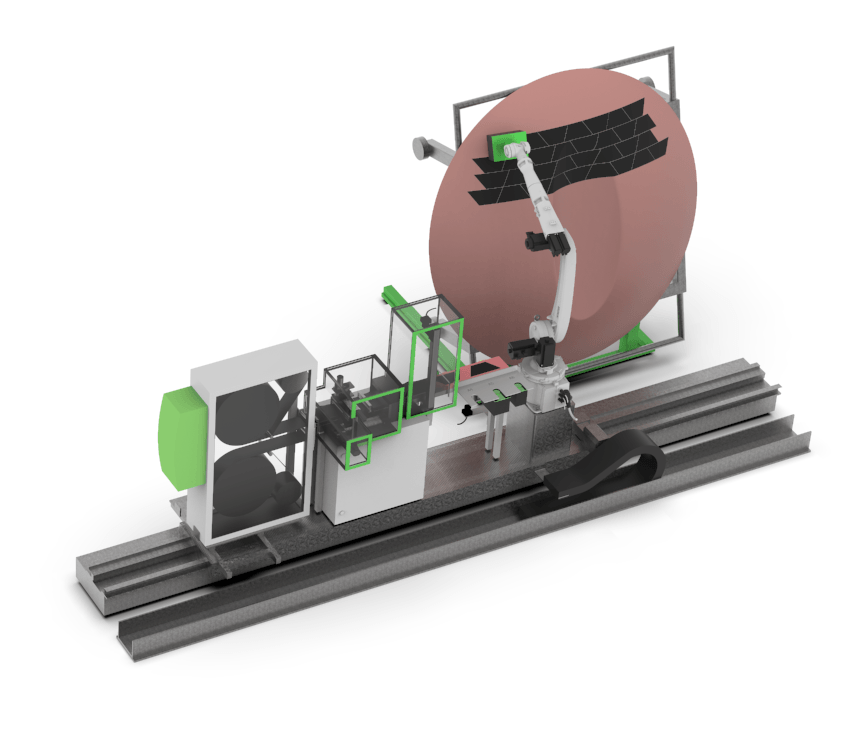Fiber Patch Placement (FPP) has become the preferred technology for the automated production of complex fiber composite components. The additive manufacturing of components with suitably-sized patches is used especially in the aerospace and automotive industries, for medical devices and sports equipment. In close cooperation with leading manufacturers of components for the aerospace industry, Cevotec further develops the entire patch placement process according to the requirements of the industry.
 Fiber Patch Placement production system SAMBA Multi
Fiber Patch Placement production system SAMBA Multi
Cevotec’s FPP specialists are particularly interested in complex sandwich components with their sophisticated material mix, such as adhesive films, glass fiber and carbon fiber layers. These different materials are used to improve the adhesion and processability of carbon fiber material with the often-used aluminum honeycomb sandwich cores. "The SAMBA Multi production systems, which we are currently developing, enables the automated lay-up of this special multi-material mix in one single system," reports Felix Michl, Cevotec's CTO. In addition to glass fiber fleeces, metal structures and wood cores, also honeycomb cores, solid foams and additional materials have already enjoyed load-adjusted fiber patch reinforcements. Depending on process requirements, this can be done in-line or parallel to line production to optimize cycle times.
SAMBA Multi has parallel feeding units for different materials that are processed in one production system and placed precisely on 3D sandwich cores or preforming tools. By mounting the FPP unit on a linear axis, the concept also enables the production of particularly long and wide components in aerospace applications. Adapted to specific component sizes, the patch grippers are scaled to DIN-A5 and DIN-A4 size to meet the requirements of common aircraft components. An integrated gripper station enables the exchange of grippers during the process.
"The automated multi-material lay-up of complex sandwich components has an extremely positive effect on process times and thus the production volume," explains Thorsten Groene, Managing Director of Cevotec: "The fiber deposition with controlled pressure and can enable manufacturers to skip intermediate compactions and thus reduce process times significantly.” In addition, Groene continues, FPP sustainably reduces recurring production costs in many applications. "Material savings of 20% - 50% play a major role, of course, but automation with FPP often enables further optimization of the overall process.”
Additional potential for cost saving results from the continuous quality control and monitoring during the production process, enabled by the numerous sensors integrated in the SAMBA systems. Particularly in the aerospace industry, an industry that does not forgive mistakes in manufacturing, the composite parts produced in today’s semi-automated production are often subject to individual unit tests to ensure specification compliance and therefore a maximum degree of flight safety. Working with Fiber Patch Placement, sensors of the production system monitor key parameters of the production process: from cutting the patches from a tape spool to pressure-controlled fiber deposition. In particular, a special vision system checks each individual patch for quality and dimensional accuracy before further processing in order to guarantee that 100% of the input material is according to specifications. This reduces the required effort for the final inspection enormously and lowers the non-pass rate of produced parts.
Production data are analyzed and compared with a database of previously processed patches. Deviations can be promptly detected and appropriate corrective measures can be taken. The system becomes more intelligent with each patch processed in the database. On the basis of this data, process tolerance specifications can be minimized, which in turn guarantees a consistently high placement quality. The time and cost required for single unit tests are significantly reduced.
On the software side, Cevotec now offers a plug-in for the modeling software HyperMesh, one of the leading FEA preprocessors. Based on the data defined in PATCH ARTIST regarding geometry, position and alignment of the patches, the ARTIST STUDIO plug-in automatically generates a detailed image of the patch laminate in HyperMesh. The contour of each individual patch is used to model fiber orientations and overlap areas. Ply-based shell models as well as solid and cohesive zone models can be used for analysis, which can be performed on both sublayer and patch level.
In addition, the new module TAPE ARTIST features all the functions for efficient laminate design with endless fiber tapes for AFP processes to combine laminate planning for AFP and FPP. Seamlessly integrated into the software platform, TAPE ARTIST transfers the laminate to MOTION ARTIST for process simulation and machine data generation.
Like SAMBA Multi, the new ARTIST STUDIO features will be presented to the public at Advanced Engineering and are available towards the end of the year.